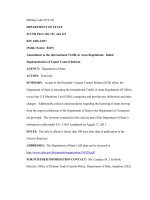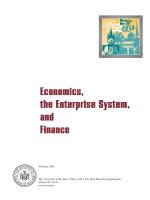The international monetary system (INTERNATIONAL FINANCE)
Bạn đang xem bản rút gọn của tài liệu. Xem và tải ngay bản đầy đủ của tài liệu tại đây (1.32 MB, 40 trang )
Objective
This chapter gives a review of the
development of the international monetary
system. The chapter also discusses the
working of macroeconomic policies under
different monetary systems.
04/02/21
182
Content
Goals of macroeconomic policies
Gold standard
Bretton Woods system
Collapse of the Bretton Woods system
International effects of US macroeconomic
policies
The current monetary system
04/02/21
183
1. Macroeconomic Goals
Internal Balance
“Internal balance” is a name given to the
macroeconomic goals of full employment (or
normal production) and price stability (or low
inflation).
Over-employment tends to lead to increased prices and
under-employment tends to lead to decreased prices.
Volatile aggregate demand and output tend to create
volatile prices.
Unexpected inflation redistributes income from creditors
to debtors and makes planning for the future more
difficult.
04/02/21
184
1. Macroeconomic Goals
Internal Balance
“External balance” is a name given to a
current account that is not “too”
negative or “too” positive.
A large current account deficit can make
foreigners think that an economy can not
repay its debts and therefore make them
stop lending, causing a financial crisis.
A large current account surplus can cause
protectionist or other political pressure by
foreign governments (e.g., pressure on Japan
in the 1980s and China in the 2000s).
04/02/21
185
1. Macroeconomic Goals
External Balance
“External balance” can also mean a
balance of payments equilibrium:
a current account (plus capital account) that
matches the non-reserve financial account in a
given period, so that official international
reserves do not change.
04/02/21
186
2. The Gold Standard
External balance
The gold standard from 1870–1914 and after
1918 had mechanisms that prevented flows
of gold reserves (the balance of payments)
from becoming too positive or too negative.
Prices tended to adjust according the amount of
gold circulating in an economy, which had effects
on the flows of goods and services: the current
account.
Central banks influenced financial capital flows, so
that the non-reserve part of the financial account
matched the current account, thereby reducing
gold outflows or inflows.
04/02/21
187
2. The Gold Standard
External balance
Price specie flow mechanism is the adjustment
of prices as gold (“specie”) flows into or out of a
country, causing an adjustment in the flow of goods.
An inflow of gold tends to inflate prices.
An outflow of gold tends to deflate prices.
If a domestic country has a current account surplus in
excess of the non-reserve financial account, gold earned
from exports flows into the country—raising prices in that
country and lowering prices in foreign countries.
04/02/21
Goods from the domestic country become expensive and goods
from foreign countries become cheap, reducing the current
account surplus of the domestic country and the deficits of the
foreign countries.
188
2. The Gold Standard
External balance
Thus, price specie flow mechanism of the
gold standard could reduce current
account surpluses and deficits, achieving a
measure of external balance for all
countries.
04/02/21
189
2. The Gold Standard
External balance
The “Rules of the Game” under the gold
standard refer to another adjustment process
that was theoretically carried out by central
banks:
When gold exits the country to pay for imports, the
money supply decreased and the interest rates
increased, attracting financial capital inflows to match a
current account deficit, reducing gold outflows.
When gold enters the country as income from exports,
the money supply increased and the interest rates
decreased, reducing financial capital inflows to match
the current account, reducing gold inflows.
04/02/21
1810
2. The Gold Standard
Internal balance
The gold standard’s record for internal
balance was mixed.
The US suffered from deflation and depression
in the 1870s and 1880s after its adherence to
the gold standard: prices (and output) were
reduced after inflation during the 1860s.
The US unemployment rate averaged 6.8%
from 1890–1913, but it averaged under 5.7%
from 1946–1992.
04/02/21
1811
2. The Gold Standard
The gold standard in interwar years
The gold standard was stopped in 1914 due to
war, but after 1918 was attempted again.
The US reinstated the gold standard from 1919–1933 at
$20.67 per ounce and from 1934–1944 at $35.00 ounce,
(a devaluation the dollar).
The UK reinstated the gold standard from 1925–1931.
But countries that adhered to the gold standard
the longest, without devaluing the paper currency,
suffered most from deflation and reduced output
in the 1930s.
04/02/21
1812
3. Bretton Woods System
In July 1944, 44 countries met in Bretton Woods,
NH
They established the Bretton Woods system:
fixed exchange rates against the US dollar and a
fixed dollar price of gold ($35 per ounce).
They also established other institutions:
The International Monetary Fund
2. The World Bank
3. General Agreement on Trade and Tariffs (GATT), the
predecessor to the World Trade Organization (WTO).
1.
04/02/21
1813
3. Bretton Woods System
International Monetary Fund
The IMF was constructed to lend to countries with
persistent balance of payments deficits (or current
account deficits), and to approve of devaluations.
Loans were made from a fund paid for by members in gold
and currencies.
Each country had a quota, which determined its contribution
to the fund and the maximum amount it could borrow.
Large loans were made conditional on the supervision of
domestic policies by the IMF: IMF conditionality.
Devaluations could occur if the IMF determined that the
economy was experiencing a “fundamental disequilibrium”.
04/02/21
1814
3. Bretton Woods System
Restriction on capital inflows
In order to avoid sudden changes in the financial
account (possibly causing a balance of payments
crisis), countries in the Bretton Woods system often
prevented flows of financial capital across countries.
Yet, they encouraged flows of goods and services
because of the view that trade benefits all
economies.
Currencies were gradually made convertible
(exchangeable) between member countries to encourage
trade in goods and services valued in different currencies.
04/02/21
1815
3. Bretton Woods System
External balance and internal balance
Under a system of fixed exchange rates, all
countries but the US had ineffective
monetary policies for internal balance.
The principal tool for internal balance was
fiscal policy (government purchases or
taxes).
The principal tools for external balance
were borrowing from the IMF, financial
capital restrictions and infrequent changes
in exchange rates.
04/02/21
1816
3. Bretton Woods System
Internal balance
Suppose internal balance in the short run occurs
when output at full employment equals aggregate
demand:
Yf = C(Yf – T) + I + G + CA(EP*/P, Yf – T)
An increase in government purchases (or a
decrease in taxes) increases aggregate demand
and output above its full employment level.
To restore internal balance in the short run, a
revaluation (a fall in E) must occur.
04/02/21
1817
3. Bretton Woods System
External balance
Suppose external balance in the short run occurs
when the current account achieves some value X:
CA(EP*/P, Y – T) = X
An increase in government purchases (or a
decrease in taxes) increases aggregate demand,
output and income, decreasing the current
account.
To restore external balance in the short run, a
devaluation (a rise in E) must occur.
04/02/21
1818
Exchange
rate, E
External balance achieved: the current
account is at its desired level
XX
Internal balance
achieved: output
is at its full
employment level
1
II
Fiscal expansion
(G or T)
04/02/21
1819
3. Bretton Woods System
Macroeconomic policies
But under the fixed exchange rates of the Bretton
Woods system, devaluations were supposed to be
infrequent, and fiscal policy was supposed to be
the main policy tool to achieve both internal and
external balance.
But in general, fiscal policy can not attain both
internal balance and external balance at the same
time.
A devaluation, however, can attain both internal
balance and external balance at the same time.
04/02/21
1820
Exchange
rate, E
Devaluation that
results in internal
and external
balance: by making
domestic goods
cheaper, aggregate
demand, output and
the current account
increase.
XX
At point 2, the
economy is below II
and XX: it experiences
low output and a low
current account
1
4
3
2
II
Fiscal expansion
Fiscal policy that results in internal or external balance: by (G or T)
reducing demand for imports and output or increasing
demand for imports and output.
04/02/21
1821
4. The collapse of Bretton Woods System
Macroeconomic policies
Under the Bretton Woods system, policy
makers generally used fiscal policy to try
to achieve internal balance for political
reasons.
Thus, an inability to adjust exchange
rates
left countries facing external imbalances
over time
04/02/21
1822
4. The collapse of Bretton Woods System
US external and internal imbalance
The collapse of the Bretton Woods system
was caused primarily by imbalances of the
US in 1960s and 1970s.
The US current account surplus became a deficit
in 1971.
Rapidly increasing government purchases
increased aggregate demand and output, as well
as prices.
A rapidly rising price level and money supply
caused the US dollar to become over-valued in
terms of gold and in terms of foreign currencies.
04/02/21
1823
04/02/21
1824
04/02/21
1825









